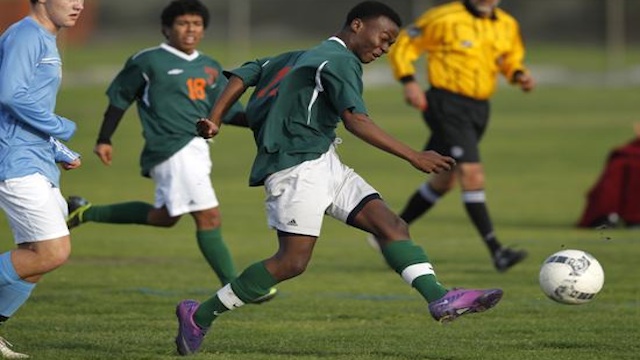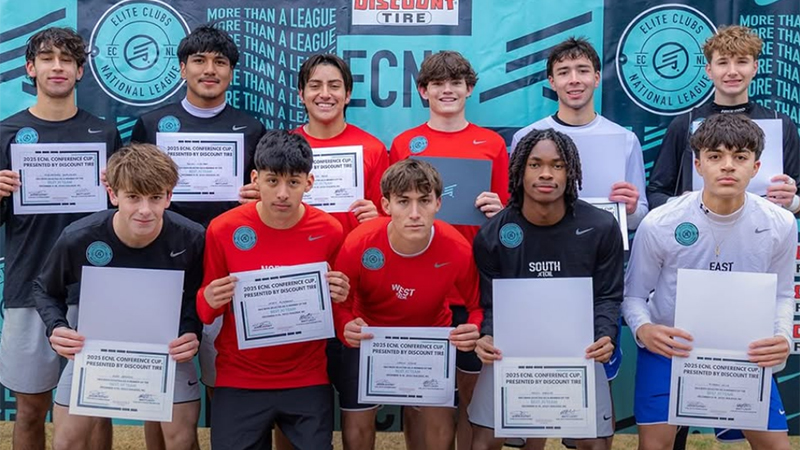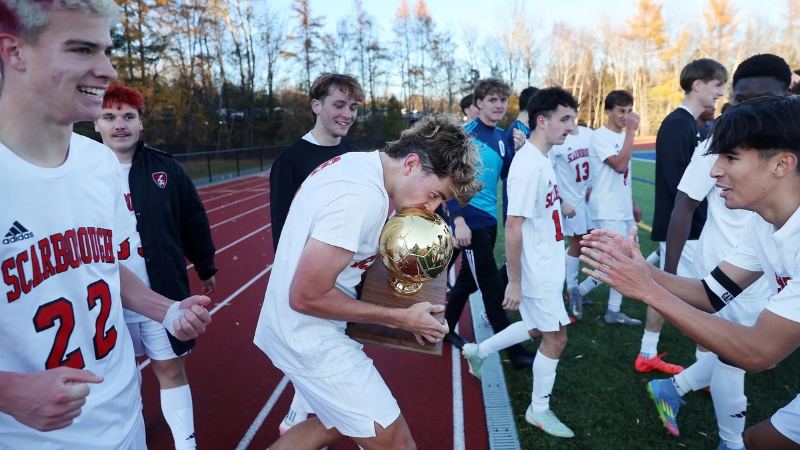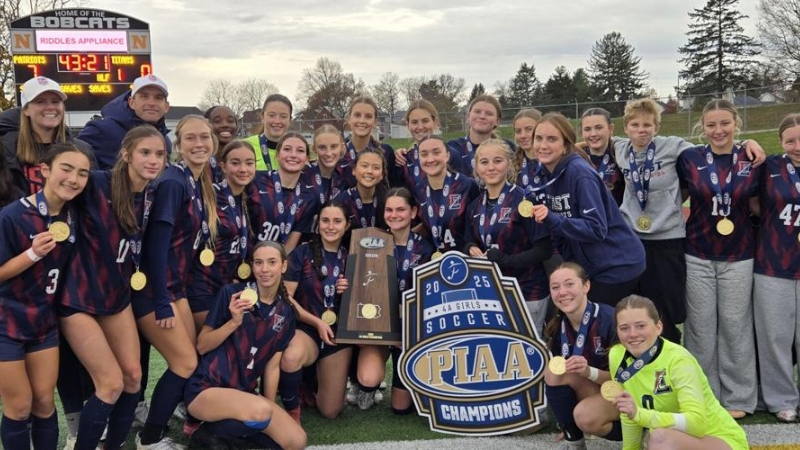San Diego HS finds hope, solidity in soccer

When he first showed up to a practice in 2009, most of his players didn't know what to call him. Coach? Surely not this gringo. Without a practice field or equipment, he told his players, all ninth grade boys, they were running through the hills of downtown San Diego for practice. A few flatly refused. One of those was Jesus Bastidas, one of the team's most talented players and one of its strongest personalities.
It was a testy moment. His first day, and already a conflict. Not a particularly comforting sign.
"It comes to like, OK, you want me to run for 30 minutes, sprint for 10, jog for 15, and then go home?" recalls Luis Flores, a member of King-Chavez High School's first team in 2009. "It was like, where's the soccer in this?"
Four years later, they'd simply call him 'H,' as much a sign of respect as it was a designator that he'd grafted himself onto the skin of the community. Four years later, and he'd become one of them. Four years later, and Bastidas is now playing college soccer on scholarship.
Kyle Hagenburger, the coach who helped take King-Chavez's fledgling soccer program and mold it into a positive vehicle for a community badly in need of one.
_____
King-Chavez was born into a cacophony of need on the southeastern side San Diego. For years, the area was serviced primarily by San Diego High School. But the area the school covered was so vast that most communities had to bus their students there. One of those communities without a school of its own was Logan Heights.
The Logan Heights neighborhood of San Diego is squashed between the traffic-choked corridors of Interstate 5 and Interstate 15. Just 15 miles from the Mexico border, the area has long been a settling place for Latino immigrants, particularly those from Mexico.
Nearby Chicano Park is home to the largest outdoor collection of murals in the country, 72 lavishly-colored displays slathered over concrete that largely celebrate Mexican heritage. One of the most stark images is the Mujer Cosmica, a 20-foot woman painted on a structural interstate pillar pointing to a sign that says 'Hecho En Aztlan,' the mythical homeland of the Aztec people.
But for decades, Logan Heights struggled to contain the gang activity that settled into the community like an unwelcome guest. The infamous Logan Heights Gang had been ensconced in the neighborhood since the 60's, often operating from Memorial Park, a green space that occupies a central location in the neighborhood. Parents would often tell their children to be clear of the streets at night.
"In terms of things going on in the community before us, pretty much nothing at night that was going on that would be considered a socially positive event," Hagenburger said. "Definitely not anything outside. Most of the things going on outside at night were gang related. It becomes a kind of ghost town after dark."
Walk a minute east from the park, across 29th Street and through a parking lot, and you'll stumble across a knobby patch of earth called Memorial Field. Surrounded by concrete sprawl and speckled on its edges with a few small palm trees, it wasn't much to look at when Hagenburger first arrived in 2009. But it would soon become ground zero for his newest project.
Hagenburger was working at a low-income charter high school in Newark, N.J. when he got the itch to return home. A San Diego native, Hagenburger went to high school at nearby Saint Augustine High School, where he played soccer and then coached. He'd spent a year in New York when he heard about a charter school opening up called King-Chavez that, in part, would service Logan Heights, one of the poorest inner-city communities in California.
In his interview, the school's principal noticed Hagenburger had experience coaching soccer. Would he be interested in starting up a program at King-Chavez?
The opportunity was too good. By the summer of 2009, Hagenburger, then just 28, was back home in San Diego, starting an inner-city program from scratch.
"Soccer is a huge part of the community and they don't have a lot of programs in that neighborhood," Hagenburger said. "There's not a lot of club opportunities, and there wasn't a high school there until our school. But there's tremendous talent. So it seemed like a really cool opportunity to develop a program, serve the needs of the community and start something that could last."
____
Hagenburger is a San Diego native, so the neighborhood wasn't a complete unknown by the time he'd gathered his first practice that first summer. But the demographics were something else. According to US News' last report, the minority enrollment in King-Chavez is 99 percent, and the school's "economically disadvantaged" numbers 76 percent. By 2009, when the school first opened its doors, the dropout rate in the neighborhood had soared to 60 percent, and the average education level was around ninth grade.
So at first, there was a palpable divide Hagenburger had to bridge.
"When we finally got to a field to start trying out, to put it in the most simple terms, I'm this white guy, and here are all these Latino boys that didn't know me soccer-wise at all," Hagenburger said. "A lot of them had no reason to trust me. We spent a great deal of time building that."
For the first week and a half, without a practice field or any equipment, all the team did was run through the downtown streets around the school. Hagenburger secured generator lights you most often see on construction sites to light games. King-Chavez started with only ninth graders and added a class each year, which meant the program's first team was essentially a U15 team. They played a JV schedule that first year as the coach got acclimated with his players.
The week leading up to King-Chavez's first game was a tempest. The school had struggled to secure a field, eventually settling on a bumpy patch of turf hardly suited for a competitive game. The day before, Hagenburger enlisted his group of freshmen to help him fill the holes on the field with spades and wheelbarrows. They spent five hours moving earth and filling holes.
It may have seemed at the time it was a throwaway moment. But it came to symbolize the team's drive to plow through any number of impediments just to play a game.
"That just showed the commitment of the team and how we all really wanted to play," said Omar Solorio, a member of Hagenburger's first team and a four-year captain. "Whatever it cost, we were going to do it."
The costs began to mount as the team became more ensconced in the community. That first year, gang members tagged the team's goalposts with graffiti. The second year, the program's first on the varsity level, starting goalkeeper Omar Rosales was approached by a group of gang members in Memorial Park on his way home from practice. When he refused to hand over his iPod and began to walk away, they beat him so severely that he was hospitalized.
"The community is known for violence and drug use and other not pretty stuff," Solorio said. "It's known for crime. When the program started, we all had a fear that was going to be a problem for us. It's pretty much starting a program that's going against all that stuff. It's difficult for us having to walk to practice and the field being right in the center of the community where everyone hangs out. It was scary at first."
While the outside world continued to violently swirl in its typical pattern, the soccer field was always a brightly lit corridor to some calmer place. In his four years at King-Chavez, Hagenburger never had an issue on the soccer field beyond those in his control: fitness, tactical nuance, tight passing corners. No violence. No encroachment from darker corners.
It wasn't just a haven unto itself. It was pulling its players into cleaner space.
"I wasn't in to any gang crimes and stuff, but I had a lot of my friends who were because I guess it was easier," Flores said. "Once you start playing for the team, it becomes more of a family. It was like, hey, why do this when you can come to practice with us? The team was always very family-oriented, so I guess that's what helped me and everyone else stay away from that type of stuff."
_____
By the time King-Chavez began life as a varsity program during Hagenburger's second year, it became obvious he'd stumbled onto a gold mine of talent. Despite the fact that only three of the 16 players in his first graduating class played club soccer, the team pinged around passes like practiced professionals.
In its first year playing varsity - halfway through his first year, Hagenburger secured Memorial Park, where the team still plays - King-Chavez improbably won the California Interscholastic Federation's Frontier League with nobody on the roster older than 16. The next year, the team went 14-8-1, won the league with a 9-1-0 record and made the quarterfinals of the CIF playoffs for the second consecutive year.
Last year was the coup de grace for King-Chavez's pioneering senior class. The Vaqueros stormed through the season without a loss until a heartbreaking defeat in the CIF semifinals ended the team's season with an 18-1-2 record. For Hagenburger, the team's ascension mirrored the strides they'd made off the field. Amidst a blinding swirl of immigration status issues, poverty, insufficient funding and sheer inexperience, the team plowed through the fog and became a rallying point for an entire neighborhood.
Hagenburger left King-Chavez after last season to become an assistant coach at Southwestern College, and it's hard to ignore the impact the soccer team has had on the community. Events at night were almost off limits when the program started. Before King-Chavez's first night game, a camera crew for the TV show 'Gangland' was filming in Memorial Park.
Now? The soccer team is Logan Heights' biggest hit, drawing upwards of 300 people on Friday nights for games.
Every member of Hagenburger's first class that graduated was the first to do so in his family, and Hagenburger and his wife Carmen are now spearheading a documentary on the program's first four years funded entirely from crowd-sourcing. They hope to have it out by late next year to document the team’s ascension from nothing to a crucible for Logan Heights. A handful of the team's first class are now playing college soccer on scholarship.
So while 'H' may have moved on, the community remembers the name.
"Now, the soccer program is like the biggest thing at the school," Solorio said. "I'm happy to be a part of the class that made it be that way. It was an amazing ride the whole time."
Headlines
- Recruiting Roundup: December 22-January 4
- How Do I Get Scouted by TopDrawerSoccer?
- 2026 Women's Division I Transfer Tracker
-
Mid-Atlantic High School Roundup - Dec.

- ECNL Boys Conference Cup Best XI
-
Commitments: In-State Decision

-
Northeast High School Roundup - Dec.

- Men's College Postseason Top 100 Freshmen
- Vote for Women's College Soccer Best Goal
-
Player Rankings Spotlight: 2027 Boys




